Operation Wayne Grey
Operation Wayne Grey was an operation carried out by the United States Army, 1st Brigade, 4th Infantry Division and supporting elements, on March 1 to April 14, 1969. Its main objective was to cut off lines of communication and supply to the 66th & 24th People's Army of Vietnam Infantry Regiments as well as preventing them from retreating into Cambodia.[1]
| Operation Wayne Grey | |||||||
|---|---|---|---|---|---|---|---|
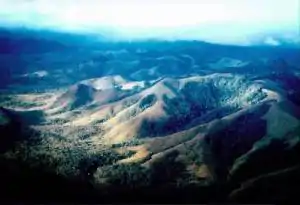 Plei Trap Valley Plei Trap Valley | |||||||
| |||||||
| Belligerents | |||||||
| The United States | Democratic Republic of Vietnam | ||||||
| Units involved | |||||||
| US Army, 4th Infantry Division, 1st Brigade | 66th & 24th PAVN Infantry Regiments | ||||||
| Strength | |||||||
| Approx: 2000 | Over: 2800 | ||||||
| Casualties and losses | |||||||
| US: 106 KIA, 437 WIA, 1 MIA | PAVN: 575 KIA, 4 POW | ||||||
Prelude
Captured documents and interrogations of POW’s revealed that in late January to early February the 66th NVA Regiment along with the 24th NVA Regiment and elements of the 40th NVA Artillery moved north into the Chu-Mon-Ray mountain area and had begun to conduct offensive operations. Aerial reconnaissance of firebases west of Polei Kleng revealed heavy vehicle traffic and construction of roads deep into the Chu-Mon-Ray mountains and from the Cambodian border into the eastern Plei Trap valley. The confirmation of artillery and possible armour units suggested that a major offensive was being planned and that their likely target was Kontum City and Camp Polei Kleng.[1]
Positioning of the 1st brigade
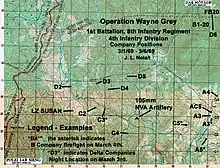
Operation Wayne Grey began on March 1, when A Company of the 3rd battalion, 12th Infantry out of Polei Mrong were combat assaulted to LZ Swinger. Their objective was to secure the LZ and establish a firebase to allow for the placement of artillery. The position would be used to support the 3/12th, 1/8th and 3/8th Infantry as they conducted operations in Plei Trap. Upon assault the first helicopter was able to land and offload without incident. After the second helicopter began offloading its troops, they were ambushed by sappers from the K25B NVA Engineer battalion. The initial firefight lasted for over three hours before the NVA retreated and the 1/92nd field artillery[2] was able to land and set up their guns. B company of the 1/8th assaulted into Firebase 20 and C company of the 3/8th into Firebase Pause followed by A & C company of the 6/29 artillery. The 6/29th Artillery was now in position to provide support for 1st Brigade’s sweep of Plei Trap. On March 2, A company of the 1/8th secured LZ Turkey and began recon operations, while companies D&C of the 1/8th assaulted to landing zone Susan. The remaining companies from the 3/8th were inserted in LZ’s in and around LZ Mary.[1][3][4]
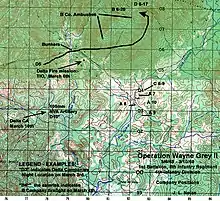
Phase I
Plei Trap Road
Operations along the Plei Trap road were conducted by companies D,C & A of the 1/8 Infantry. Beginning on March 1, with the support of the A/7-17th Air Cavalry the 1/8th was able to locate and destroy communications, supplies and vehicles along the Plei Trap road, as well as the recapturing of two US 105mm Howitzers captured by the NVA. On March 7 D company moved overland to Firebase 20 to assist B company in patrols to help patrol Hill 1030. A&C companies continued operations along the Plei Trap road. On March 12 while assessing the damage of a B-52 strike on a suspected NVA company in bunkers to their southeast, A&C companies came into contact with NVA troops. Both companies were shelled throughout the night by NVA mortar fire. On the 17th of March A & C companies formed a new patrol base out of Hill 467 from which to conduct joint patrols. By the end of the mission the 1/8th had successfully dealt a heavy blow to the 40th NVA Artillery’s ability to conduct operations by positioning itself alongside their line of communication and halting the flow of supplies to the 40th Artillery.[1][3]
Landing Zone Brace
Landing zone Brace was the largest and most significant battle of Operation Wayne Grey. It began on March 3 when A company of the 3/8th Infantry came into contact with a battalion of NVA troops at their HQ at the top of Brace. A company suffered heavy casualties during the battle and was forced to retreat. It was extracted on March 4 after heavy fighting at its night location. After the 4th , A company ceased to exist as a fighting force and was evacuated to lZ pause. A company’s CO was killed during the battle. B&C companies of the 3/8th, were successful at taking the hill on the 6th of March. A firebase was constructed after the LZ was secured and on the 16th of March C company of the 6/29th Artillery was placed there along with the remainder of A 3/8th and the 3/8th Infantry HQ.[1][5]
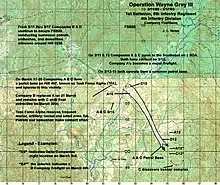
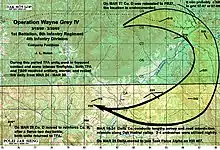
Firebase 20
Firebase 20 was established on March 2 by B company of the 1/8th Infantry when they were flown in to secure the base for artillery placement by the 6/29th. On the 7th of March D company joined B company in securing the hill and conducted recon and ambush operations around the LZ and at the base of Hill 1030.[1][3]
Hill 497
Hill 497 was established on March 3 as a blocking position by D company of the 3/8th Infantry, for NVA soldiers retreating from LZ Brace. The position was attacked several times between the 3rd and the 8th of March as well as being under constant mortar and artillery fire. D company was successful in holding the hill against NVA attacks and by the afternoon on March 8, the NVA gave up trying to take the position. Between the 10th and 14 March, task force Swift consisting of B&C companies of the 3/12th along with a recon platoon, consolidated on Hill 497. On the 11th, Swift came into contact with an NVA company while conducting recon and pulled back to their perimeter to call in B-52 airstrikes; they were again shelled by mortar fire. The next day they assaulted and took the NVA position.[1][5]
Phase II
Task Force Alpha
After C&A companies had located and destroyed an NVA force to the south of Hill 467 they reorganised into task force alpha on March 17. Their mission was to establish company size blocking positions between their base at Hill 467 and Firebase 20, with the aim of cutting off supplies and reinforcements of the NVA in the area. Cratering charges were also used to stifle operations along the Plei Trap road by rendering it impassable to vehicles. Operations continued in the area until March 30, the NVA employed heavy use of mortar and artillery at the 4th division's firbases in the area and even propaganda leaflets urging US soldiers to surrender. Task force Alpha was extracted on March 30.[1][3]
Cu-Don Mountain
Cu-Don was a known enemy base situated on a ridgeline south of LZ Brace and was suspected to be the withdrawal point of the 66th NVA Infantry. The mission for the 3/12th was to block and harass the NVA from retreating. On March, 14th A&C companies along with a recon platoon, assaulted into LZ Cider to secure it as a firebase for B battery of the 6/29th artillery. D company secured LZ D-Handle for placements of 4.2” mortars and B company moved overland to a patrol base at YA818856. Heavy contact was made on March 18th when D company came into contact with a complex of NVA bunkers. Contact was broken and artillery and mortars were called in. The next day the position was saturated by artillery fire and gunships all day. On the 20th, D company attempted to assault the bunkers with the aid of artillery and air support, but were beaten off by the NVA defenders. D company fell back to LZ D-Handle. On the 22nd after a heavy artillery barrage D company seized the hill without any opposition. On the 27th A company had contact near LZ Cider and were forced to break contact after taking mortar fire and suffering casualties. They were forced to leave their MIA. When they attempted to retrieve their MIA the next day, they again were forced to retreat back to LZ Cider under mortar fire. B company was attacked at their ambush site by B-40 rockets and D company at LZ D-Handle were attacked by sapper units who managed to destroy two bunkers with rocket fire; the attack was eventually repelled with artillery fire. On the 30th, A company again tried to retrieve its MIA from the 27th. They succeeded, but were forced to retreat again when the NVA deployed mortars. A company withdrew and linked with C company to secure a night location. The location was then subsequently bombarded by multiple B-52 strikes.
After the 3/12th withdrew, the 1/22nd Infantry was assaulted to LZ Cider and YA806827 on April 2nd. Their objective was to secure “Target Red”, the bunker complex that had forced A 3/12 to retreat. The position was saturated by artillery and gunship fire while the 1/22 conducted recon of the target under heavy fire. The 1/22nd was extracted on April 13 and the remainder of the 3/12 on April 14.[1][3]
Aftermath
Operation Wayne Grey concluded on the 14th of April 1969. It resulted in the US army’s 4th Division 1st Brigade, inflicting heavy casualties on the PAVN's 66th& 24th Infantry Regiments and its supporting elements. While the NVA was able to retreat back into Cambodia, Operation Wayne Grey was considered a success as it prevented any immediate attack against Kontum from materialising. It is also an example of conventional warfare in the Vietnam War. Attacks on both sides were preceded and followed by artillery, the NVA also applied anti aircraft weaponry and tactics to counter the US’s air superiority and both sides were well equipped.[1]
Location of Captured Artillery
According to witnesses of the assault, namely a Lt. Nolan and Capt. Yamashita they have always believed that the mission took place over the border in Cambodia and not in Vietnam as the after action report and map coordinates say. They explain how the men of D company were not given the coordinates of their landing zone or their usual maps, but instead hard to read black and white topographic maps that required extensive training to read. This coupled with the fact that the company was in the air for a lot longer then would they would have normally been for a flight of that distance and significant differences in the terrain,(the map said they were on a hill when they were not) then what the map showed, added to Nolan and Yamashita’s suspicions. It is also worth noting that eight days after D company recaptured the artillery pieces and about halfway through the operation, the US Strategic Air Command began its secret bombing campaign against Cambodia.[3]
References
- Hale, Knight (April 30, 1969). "Combat Operation After Action Report for Operation Wayne Grey" (PDF). ivydragoons.org. Retrieved August 30, 2020.
- Thompson, Lee. "A BATTLE ABOVE THE PLEI TRAP VALLEY". bravecannons.org/. Retrieved August 31, 2020.
- Nolan, J.L. (March 1–31, 1969). "4th Platoon, Company D, 1st BN, 8th Infantry, 4th,Division,Vietnam,Nov. 1968 – Aug. 1969 J. L. Nolan". swampfox.info. Retrieved August 30, 2020.
- Fisher, Dan. "30 Years Later: A Vietnam Mystery". members.tripod.com. Retrieved August 30, 20. Check date values in:
|access-date=(help) - Hickey, Pennel (March 14, 1969). "Combat Operations After Action Report" (PDF). ivydragoons.org. Retrieved August 25, 2020.